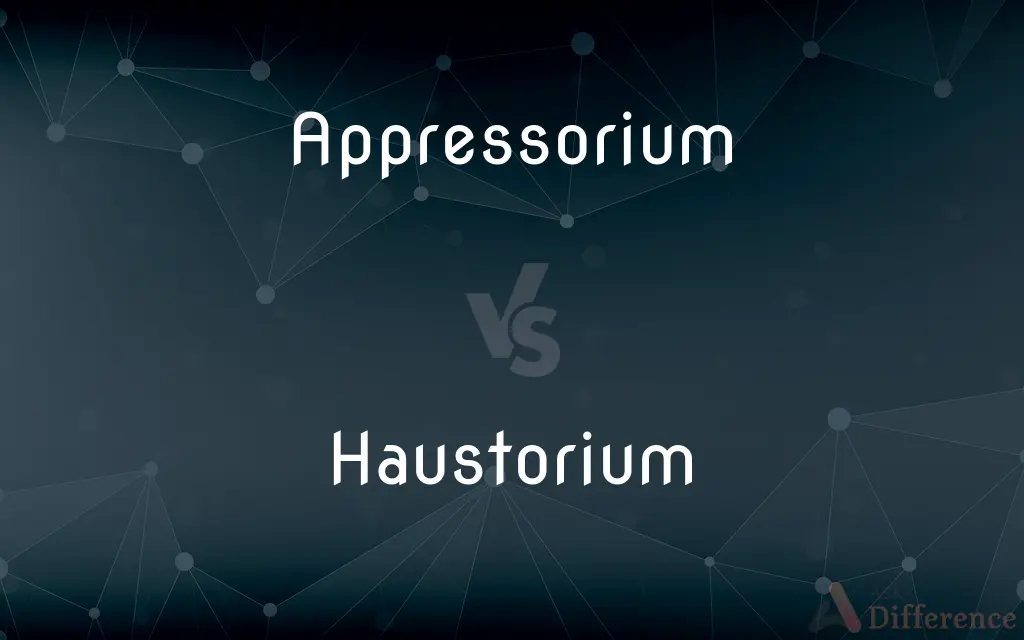Appressorium vs. Haustorium — What's the Difference?
By Fiza Rafique & Urooj Arif — Updated on March 13, 2024
Appressoria are specialized structures fungi use to adhere to and penetrate host surfaces, while haustoria are intracellular structures that extract nutrients.

Difference Between Appressorium and Haustorium
Table of Contents
ADVERTISEMENT
Key Differences
Appressoria are developed by pathogenic fungi and some oomycetes to breach the outer barriers of their host plants. They are tough, melanized structures that generate enormous turgor pressure, enabling the penetration peg to pierce the host's epidermal cells. On the other hand, haustoria are developed by parasitic plants and some fungi after successful invasion, forming intimate associations with the host cells to siphon off nutrients without causing immediate harm to the cell.
Appressoria are a critical first step in the infection process of many plant pathogens, enabling them to establish a foothold on the plant surface. Whereas haustoria play a crucial role in the nutrient acquisition stage, facilitating a parasitic relationship where the pathogen sustains itself at the expense of the host plant.
The development of appressoria is triggered by surface signals from the host plant, such as topography and chemical cues, signaling the pathogen to initiate infection. In contrast, the formation of haustoria is often a response to successful penetration into the host tissue, indicating a transition from invasive to parasitic lifestyle.
Appressoria primarily function as mechanical tools to break through physical barriers. Meanwhile, haustoria are specialized for biochemical interactions with the host, involving the transfer of nutrients and, sometimes, pathogenic molecules that modulate host defenses.
While appressoria are found on the surface of host tissues, acting as entry points for pathogens, haustoria are embedded within the host cells, establishing a complex network of nutrient exchange that supports the pathogen's growth and reproduction.
ADVERTISEMENT
Comparison Chart
Function
Aids in penetration of host surface
Absorbs nutrients from host
Location
External, on host surface
Internal, within host tissues
Development Trigger
Surface cues from the host
Successful host penetration
Role in Infection
Initiates infection process
Facilitates nutrient uptake
Structure
Hardened, melanized
Intracellular, complex
Compare with Definitions
Appressorium
A specialized structure that facilitates fungal penetration into host plants.
The fungus forms an appressorium over the stomatal opening.
Haustorium
Developed by parasitic plants and fungi within host cells.
The haustorium forms after the fungus penetrates the host cell.
Appressorium
Developed by pathogenic fungi to adhere and penetrate host surfaces.
The appressorium generates high turgor pressure for penetration.
Haustorium
Intracellular and involved in nutrient transfer.
The haustorium intricately interacts with host cell structures for nutrient exchange.
Appressorium
Associated with plant pathogenic fungi and oomycetes.
Oomycetes develop appressoria to infect aquatic plants.
Haustorium
Facilitates a sustained parasitic relationship with the host.
Through the haustorium, the parasite siphons off sugars from the host.
Appressorium
Critical for the initial infection process.
Without an appressorium, the fungus cannot invade its host.
Haustorium
Essential for the parasite's growth and reproduction.
The haustorium supports the fungal infection by ensuring nutrient supply.
Appressorium
A melanized, dome-shaped structure.
The appressorium's melanization is key to its function.
Haustorium
A parasitic structure that extracts nutrients from host plants.
The haustorium deeply embeds into the host tissue for nutrient uptake.
Appressorium
An appressorium is a specialized cell typical of many fungal plant pathogens that is used to infect host plants. It is a flattened, hyphal "pressing" organ, from which a minute infection peg grows and enters the host, using turgor pressure capable of punching through even Mylar.Following spore attachment and germination on the host surface, the emerging germ tube perceives physical cues such as surface hardness and hydrophobicity, as well as chemical signals including wax monomers that trigger appressorium formation.
Haustorium
In botany and mycology, a haustorium (plural haustoria) is a rootlike structure that grows into or around another structure to absorb water or nutrients. For example, in mistletoe or members of the broomrape family, the structure penetrates the host's tissue and draws nutrients from it.
Appressorium
The flattened tip of a hypha in various species of parasitic fungi, from which a filament emerges that penetrates the host's tissues.
Haustorium
A specialized structure of a parasitic fungus or plant, used to absorb nutrients and water from the host plant.
Appressorium
(mycology) A bulbous formation produced by parasitic fungi that is well attached to the cuticle of the host and from where a peg-shaped hypha is formed that penetrates the cuticle.
Haustorium
A root of a parasitic plant modified to take nourishment from its host.
Haustorium
A cellular structure, growing into or around another structure to absorb water or nutrients, such as a cotyledon.
Haustorium
One of the suckerlike rootlets of such plants as the dodder and ivy.
Haustorium
A rootlike attachment in parasitic plants that penetrates and obtains food from the host
Common Curiosities
What is an appressorium?
An appressorium is a specialized structure used by certain fungi and oomycetes to adhere to and penetrate the host's surface.
How does a haustorium function?
A haustorium functions by forming intimate associations with host cells to extract nutrients, supporting the parasitic organism's growth and reproduction.
What triggers the development of an appressorium?
The development of an appressorium is triggered by surface cues from the host, such as topography and chemical signals.
Can haustoria harm the host plant?
While haustoria are designed to extract nutrients, they typically do so in a way that maintains the host's viability, at least initially.
Do all parasitic plants develop haustoria?
Many, but not all, parasitic plants develop haustoria to establish a nutrient exchange with their hosts.
Can the absence of appressoria or haustoria hinder infection?
Yes, the absence of either structure can significantly impede the pathogen's ability to infect and extract nutrients from the host.
Are appressoria found in all types of fungi?
No, appressoria are specific to pathogenic fungi that require mechanical penetration into their host plants.
How do appressoria and haustoria differ in location?
Appressoria are external, located on the host surface, while haustoria are internal, embedded within host tissues.
Can a fungus form both appressoria and haustoria?
Yes, some fungi form appressoria to enter the host and then develop haustoria to extract nutrients.
Is the function of an appressorium purely mechanical?
Yes, the primary function of an appressorium is mechanical penetration of the host's surface barriers.
What are the structural differences between appressoria and haustoria?
Appressoria are hardened, melanized structures on the host surface, while haustoria are intracellular, complex structures within the host tissues.
Do appressoria directly extract nutrients from the host?
No, appressoria facilitate penetration into the host, but it's the haustoria that extract nutrients.
How do environmental conditions affect the development of appressoria and haustoria?
Environmental conditions such as humidity and temperature can influence the development and effectiveness of both appressoria and haustoria in the infection process.
How do haustoria contribute to the spread of disease?
By facilitating nutrient uptake, haustoria support the pathogen's growth and reproduction, which can contribute to the spread of disease.
Are haustoria specific to any stage of infection?
Haustoria are associated with the nutrient acquisition stage of infection, following successful penetration.
Share Your Discovery

Previous Comparison
Whistle vs. Kazoo
Next Comparison
Lotion vs. ShampooAuthor Spotlight
Written by
Fiza RafiqueFiza Rafique is a skilled content writer at AskDifference.com, where she meticulously refines and enhances written pieces. Drawing from her vast editorial expertise, Fiza ensures clarity, accuracy, and precision in every article. Passionate about language, she continually seeks to elevate the quality of content for readers worldwide.
Co-written by
Urooj ArifUrooj is a skilled content writer at Ask Difference, known for her exceptional ability to simplify complex topics into engaging and informative content. With a passion for research and a flair for clear, concise writing, she consistently delivers articles that resonate with our diverse audience.
















































